Critical Analysis: Marketing Strategies & Business Sustainability
VerifiedAdded on 2023/06/10
|7
|1464
|420
Essay
AI Summary
This essay provides a critical analysis of marketing strategies in relation to business sustainability. It explores the influence of the micro and macro environment, highlighting economic, competitive, technological, social, and cultural factors, as well as consumer behavior. The essay discusses various segmentation strategies including demographic, geographic, psychographic, behavioral, mass marketing, differentiated marketing, niche marketing, and micromarketing. It also examines contemporary marketing strategies, particularly the impact of social media and the importance of trust in building customer relationships. The analysis emphasizes the shift from traditional, institution-focused marketing to value-driven, long-term approaches, and the challenges of maintaining ethical practices and consumer trust in the digital age. Desklib provides access to similar solved assignments and resources for students.
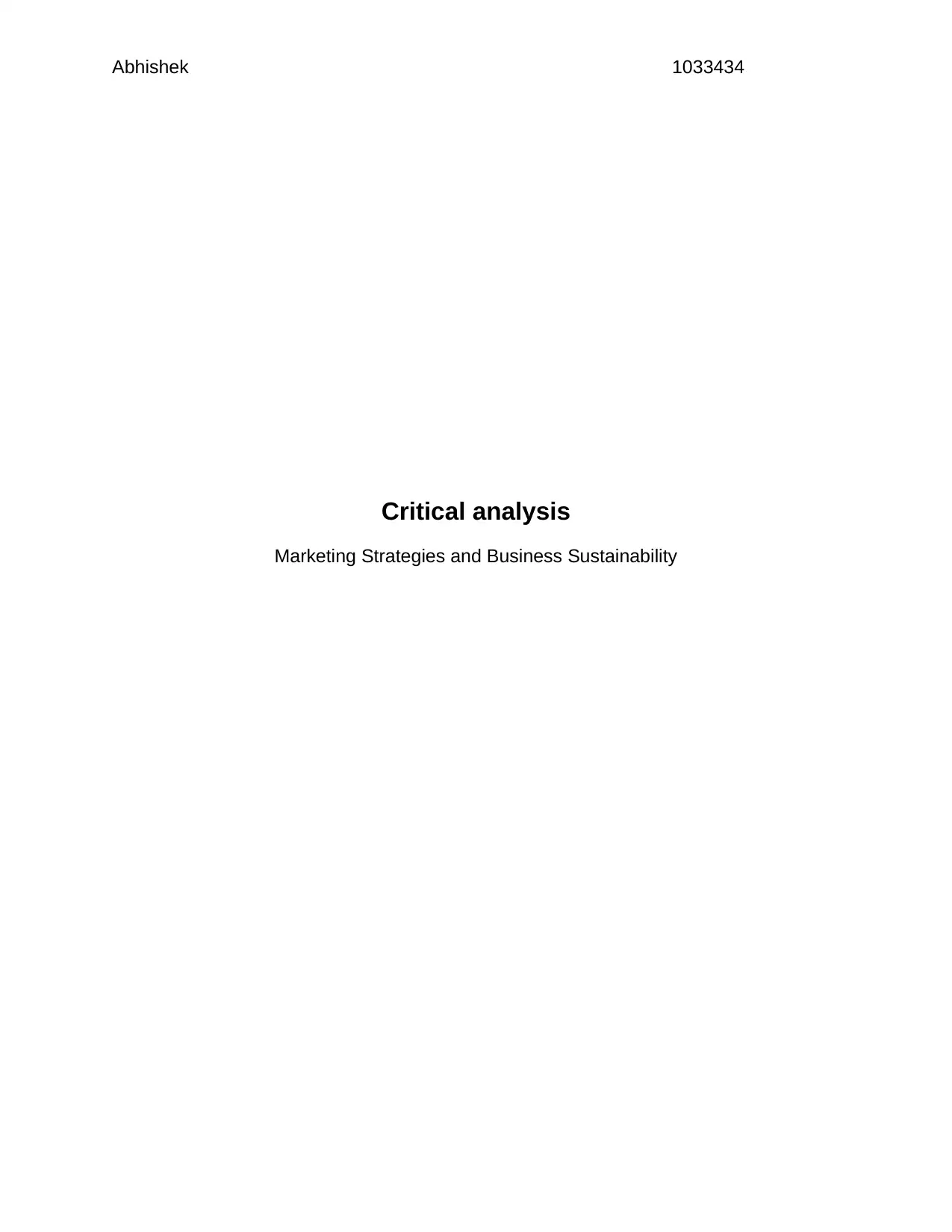
Abhishek 1033434
Critical analysis
Marketing Strategies and Business Sustainability
Critical analysis
Marketing Strategies and Business Sustainability
Paraphrase This Document
Need a fresh take? Get an instant paraphrase of this document with our AI Paraphraser
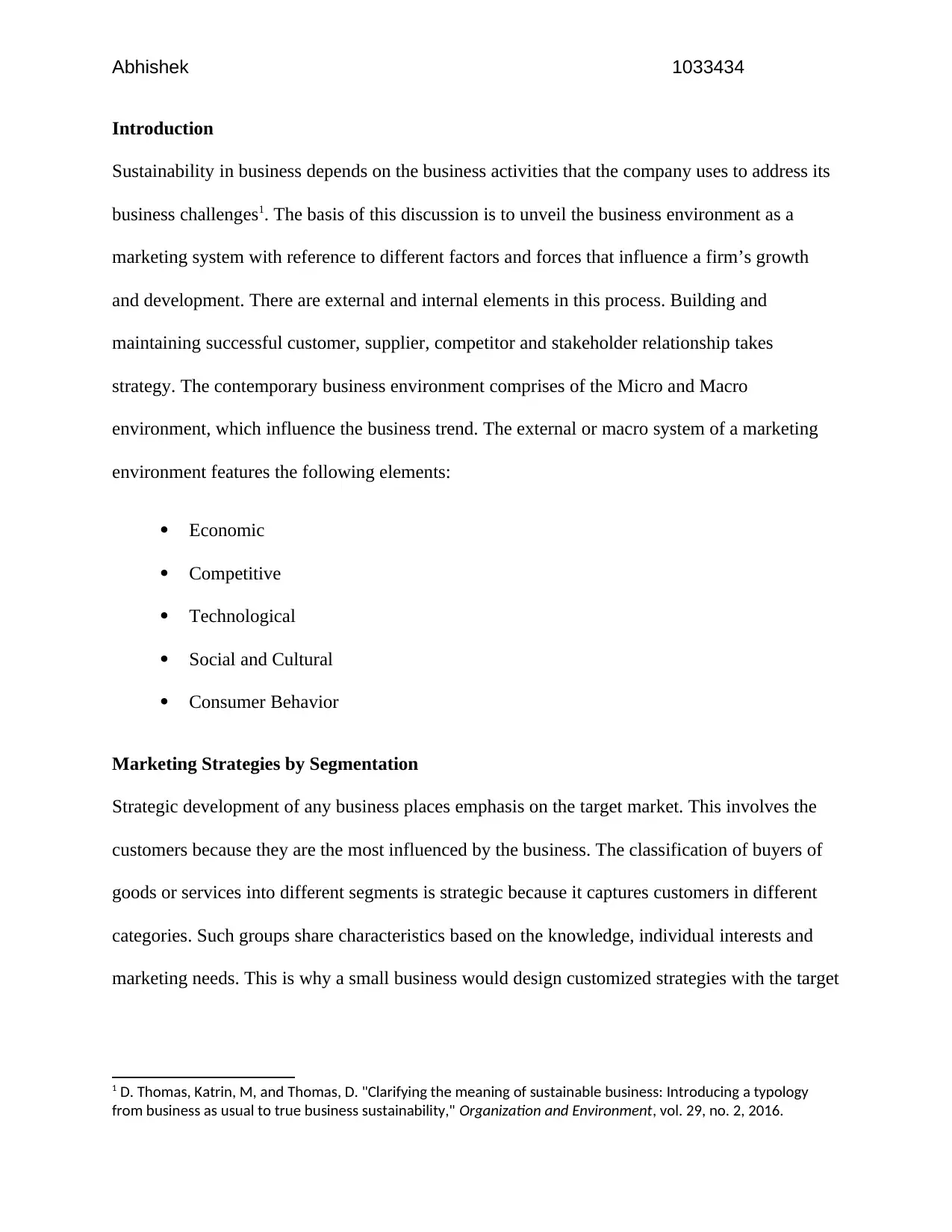
Abhishek 1033434
Introduction
Sustainability in business depends on the business activities that the company uses to address its
business challenges1. The basis of this discussion is to unveil the business environment as a
marketing system with reference to different factors and forces that influence a firm’s growth
and development. There are external and internal elements in this process. Building and
maintaining successful customer, supplier, competitor and stakeholder relationship takes
strategy. The contemporary business environment comprises of the Micro and Macro
environment, which influence the business trend. The external or macro system of a marketing
environment features the following elements:
Economic
Competitive
Technological
Social and Cultural
Consumer Behavior
Marketing Strategies by Segmentation
Strategic development of any business places emphasis on the target market. This involves the
customers because they are the most influenced by the business. The classification of buyers of
goods or services into different segments is strategic because it captures customers in different
categories. Such groups share characteristics based on the knowledge, individual interests and
marketing needs. This is why a small business would design customized strategies with the target
1 D. Thomas, Katrin, M, and Thomas, D. "Clarifying the meaning of sustainable business: Introducing a typology
from business as usual to true business sustainability," Organization and Environment, vol. 29, no. 2, 2016.
Introduction
Sustainability in business depends on the business activities that the company uses to address its
business challenges1. The basis of this discussion is to unveil the business environment as a
marketing system with reference to different factors and forces that influence a firm’s growth
and development. There are external and internal elements in this process. Building and
maintaining successful customer, supplier, competitor and stakeholder relationship takes
strategy. The contemporary business environment comprises of the Micro and Macro
environment, which influence the business trend. The external or macro system of a marketing
environment features the following elements:
Economic
Competitive
Technological
Social and Cultural
Consumer Behavior
Marketing Strategies by Segmentation
Strategic development of any business places emphasis on the target market. This involves the
customers because they are the most influenced by the business. The classification of buyers of
goods or services into different segments is strategic because it captures customers in different
categories. Such groups share characteristics based on the knowledge, individual interests and
marketing needs. This is why a small business would design customized strategies with the target
1 D. Thomas, Katrin, M, and Thomas, D. "Clarifying the meaning of sustainable business: Introducing a typology
from business as usual to true business sustainability," Organization and Environment, vol. 29, no. 2, 2016.
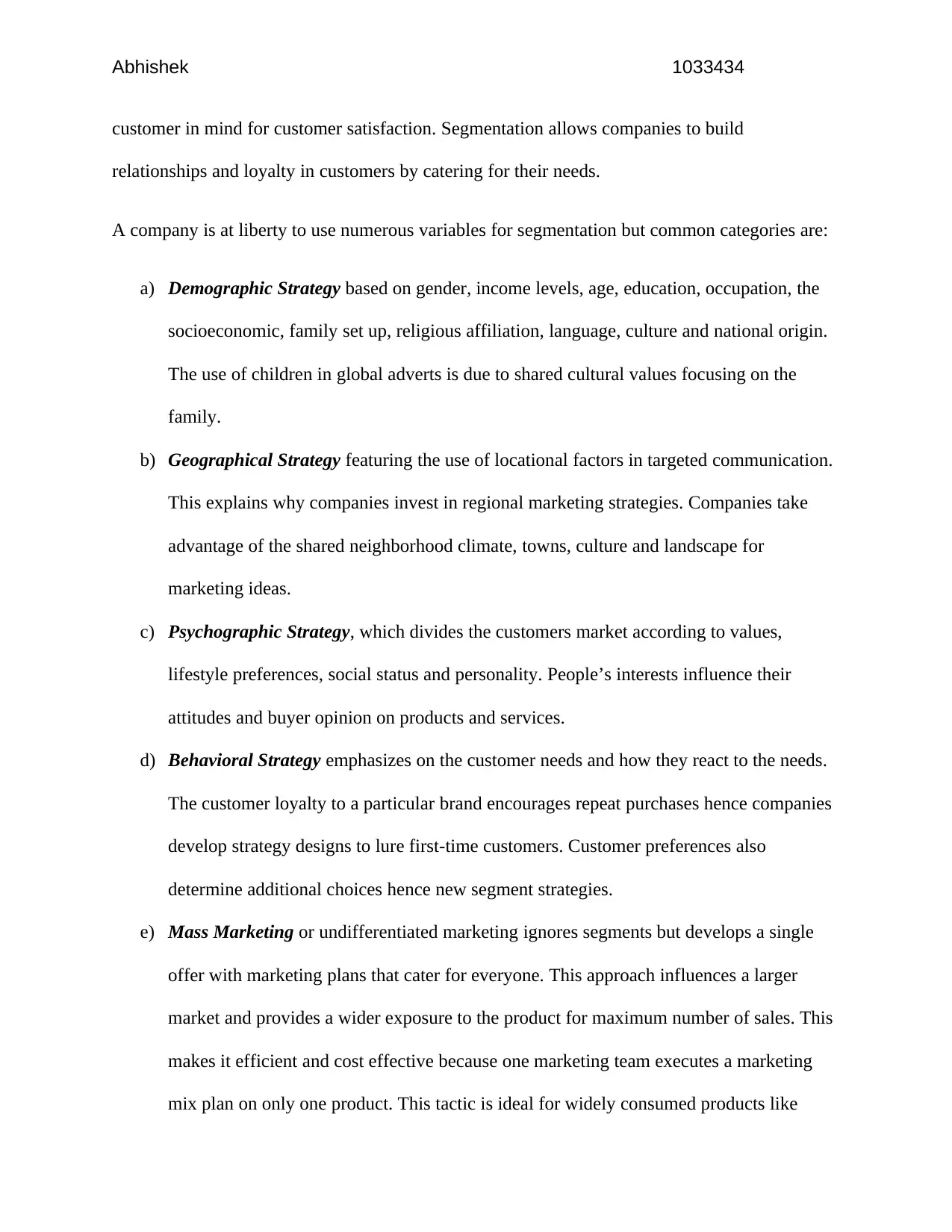
Abhishek 1033434
customer in mind for customer satisfaction. Segmentation allows companies to build
relationships and loyalty in customers by catering for their needs.
A company is at liberty to use numerous variables for segmentation but common categories are:
a) Demographic Strategy based on gender, income levels, age, education, occupation, the
socioeconomic, family set up, religious affiliation, language, culture and national origin.
The use of children in global adverts is due to shared cultural values focusing on the
family.
b) Geographical Strategy featuring the use of locational factors in targeted communication.
This explains why companies invest in regional marketing strategies. Companies take
advantage of the shared neighborhood climate, towns, culture and landscape for
marketing ideas.
c) Psychographic Strategy, which divides the customers market according to values,
lifestyle preferences, social status and personality. People’s interests influence their
attitudes and buyer opinion on products and services.
d) Behavioral Strategy emphasizes on the customer needs and how they react to the needs.
The customer loyalty to a particular brand encourages repeat purchases hence companies
develop strategy designs to lure first-time customers. Customer preferences also
determine additional choices hence new segment strategies.
e) Mass Marketing or undifferentiated marketing ignores segments but develops a single
offer with marketing plans that cater for everyone. This approach influences a larger
market and provides a wider exposure to the product for maximum number of sales. This
makes it efficient and cost effective because one marketing team executes a marketing
mix plan on only one product. This tactic is ideal for widely consumed products like
customer in mind for customer satisfaction. Segmentation allows companies to build
relationships and loyalty in customers by catering for their needs.
A company is at liberty to use numerous variables for segmentation but common categories are:
a) Demographic Strategy based on gender, income levels, age, education, occupation, the
socioeconomic, family set up, religious affiliation, language, culture and national origin.
The use of children in global adverts is due to shared cultural values focusing on the
family.
b) Geographical Strategy featuring the use of locational factors in targeted communication.
This explains why companies invest in regional marketing strategies. Companies take
advantage of the shared neighborhood climate, towns, culture and landscape for
marketing ideas.
c) Psychographic Strategy, which divides the customers market according to values,
lifestyle preferences, social status and personality. People’s interests influence their
attitudes and buyer opinion on products and services.
d) Behavioral Strategy emphasizes on the customer needs and how they react to the needs.
The customer loyalty to a particular brand encourages repeat purchases hence companies
develop strategy designs to lure first-time customers. Customer preferences also
determine additional choices hence new segment strategies.
e) Mass Marketing or undifferentiated marketing ignores segments but develops a single
offer with marketing plans that cater for everyone. This approach influences a larger
market and provides a wider exposure to the product for maximum number of sales. This
makes it efficient and cost effective because one marketing team executes a marketing
mix plan on only one product. This tactic is ideal for widely consumed products like
⊘ This is a preview!⊘
Do you want full access?
Subscribe today to unlock all pages.

Trusted by 1+ million students worldwide
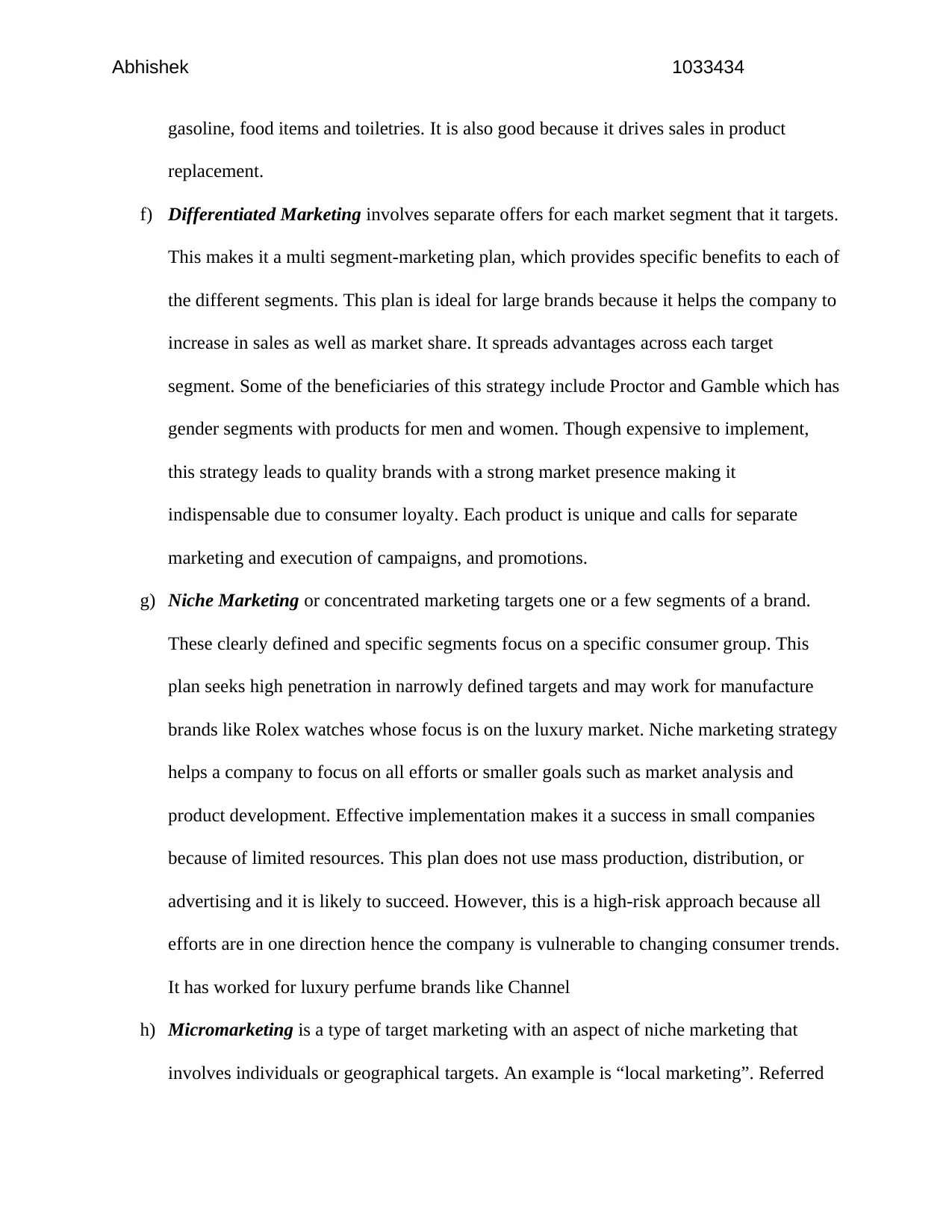
Abhishek 1033434
gasoline, food items and toiletries. It is also good because it drives sales in product
replacement.
f) Differentiated Marketing involves separate offers for each market segment that it targets.
This makes it a multi segment-marketing plan, which provides specific benefits to each of
the different segments. This plan is ideal for large brands because it helps the company to
increase in sales as well as market share. It spreads advantages across each target
segment. Some of the beneficiaries of this strategy include Proctor and Gamble which has
gender segments with products for men and women. Though expensive to implement,
this strategy leads to quality brands with a strong market presence making it
indispensable due to consumer loyalty. Each product is unique and calls for separate
marketing and execution of campaigns, and promotions.
g) Niche Marketing or concentrated marketing targets one or a few segments of a brand.
These clearly defined and specific segments focus on a specific consumer group. This
plan seeks high penetration in narrowly defined targets and may work for manufacture
brands like Rolex watches whose focus is on the luxury market. Niche marketing strategy
helps a company to focus on all efforts or smaller goals such as market analysis and
product development. Effective implementation makes it a success in small companies
because of limited resources. This plan does not use mass production, distribution, or
advertising and it is likely to succeed. However, this is a high-risk approach because all
efforts are in one direction hence the company is vulnerable to changing consumer trends.
It has worked for luxury perfume brands like Channel
h) Micromarketing is a type of target marketing with an aspect of niche marketing that
involves individuals or geographical targets. An example is “local marketing”. Referred
gasoline, food items and toiletries. It is also good because it drives sales in product
replacement.
f) Differentiated Marketing involves separate offers for each market segment that it targets.
This makes it a multi segment-marketing plan, which provides specific benefits to each of
the different segments. This plan is ideal for large brands because it helps the company to
increase in sales as well as market share. It spreads advantages across each target
segment. Some of the beneficiaries of this strategy include Proctor and Gamble which has
gender segments with products for men and women. Though expensive to implement,
this strategy leads to quality brands with a strong market presence making it
indispensable due to consumer loyalty. Each product is unique and calls for separate
marketing and execution of campaigns, and promotions.
g) Niche Marketing or concentrated marketing targets one or a few segments of a brand.
These clearly defined and specific segments focus on a specific consumer group. This
plan seeks high penetration in narrowly defined targets and may work for manufacture
brands like Rolex watches whose focus is on the luxury market. Niche marketing strategy
helps a company to focus on all efforts or smaller goals such as market analysis and
product development. Effective implementation makes it a success in small companies
because of limited resources. This plan does not use mass production, distribution, or
advertising and it is likely to succeed. However, this is a high-risk approach because all
efforts are in one direction hence the company is vulnerable to changing consumer trends.
It has worked for luxury perfume brands like Channel
h) Micromarketing is a type of target marketing with an aspect of niche marketing that
involves individuals or geographical targets. An example is “local marketing”. Referred
Paraphrase This Document
Need a fresh take? Get an instant paraphrase of this document with our AI Paraphraser
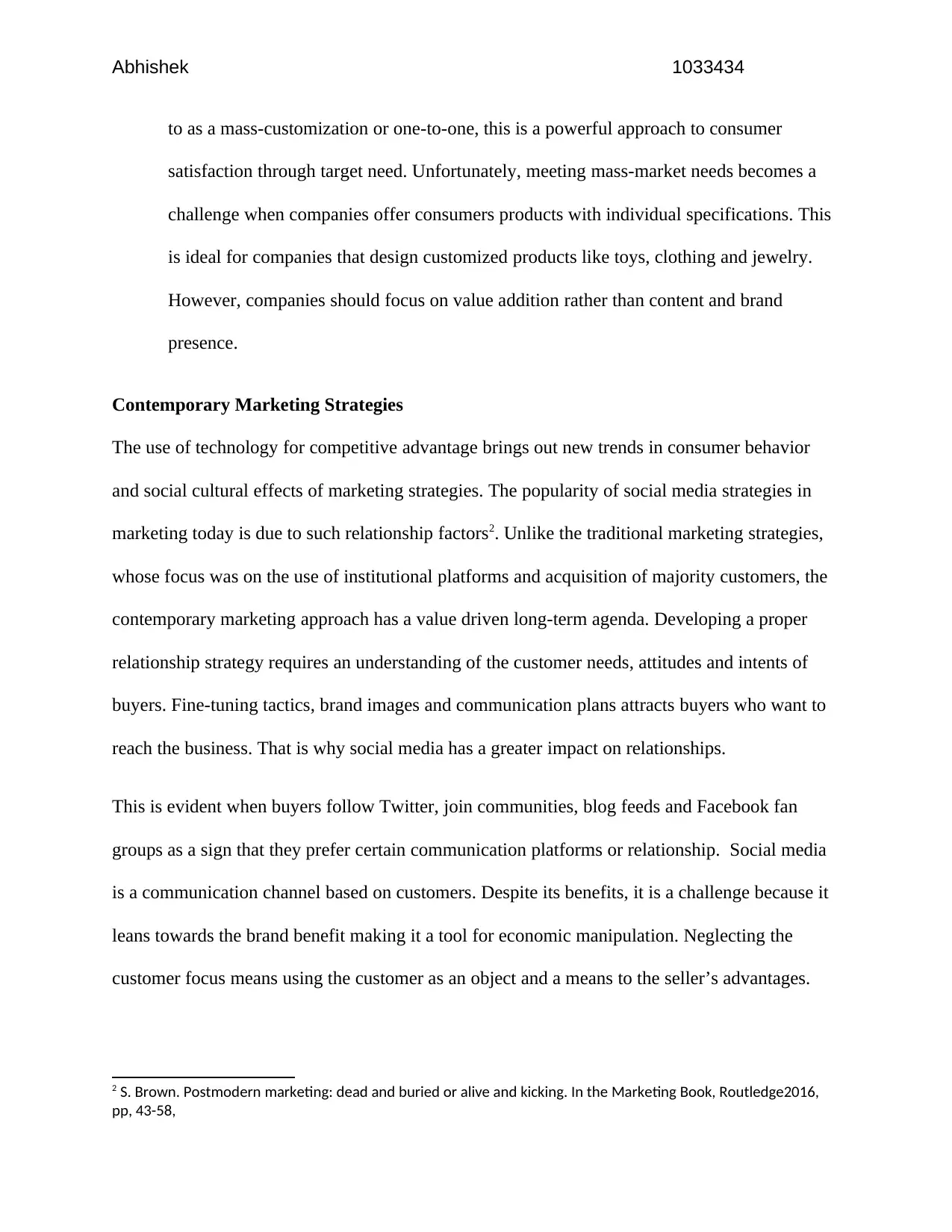
Abhishek 1033434
to as a mass-customization or one-to-one, this is a powerful approach to consumer
satisfaction through target need. Unfortunately, meeting mass-market needs becomes a
challenge when companies offer consumers products with individual specifications. This
is ideal for companies that design customized products like toys, clothing and jewelry.
However, companies should focus on value addition rather than content and brand
presence.
Contemporary Marketing Strategies
The use of technology for competitive advantage brings out new trends in consumer behavior
and social cultural effects of marketing strategies. The popularity of social media strategies in
marketing today is due to such relationship factors2. Unlike the traditional marketing strategies,
whose focus was on the use of institutional platforms and acquisition of majority customers, the
contemporary marketing approach has a value driven long-term agenda. Developing a proper
relationship strategy requires an understanding of the customer needs, attitudes and intents of
buyers. Fine-tuning tactics, brand images and communication plans attracts buyers who want to
reach the business. That is why social media has a greater impact on relationships.
This is evident when buyers follow Twitter, join communities, blog feeds and Facebook fan
groups as a sign that they prefer certain communication platforms or relationship. Social media
is a communication channel based on customers. Despite its benefits, it is a challenge because it
leans towards the brand benefit making it a tool for economic manipulation. Neglecting the
customer focus means using the customer as an object and a means to the seller’s advantages.
2 S. Brown. Postmodern marketing: dead and buried or alive and kicking. In the Marketing Book, Routledge2016,
pp, 43-58,
to as a mass-customization or one-to-one, this is a powerful approach to consumer
satisfaction through target need. Unfortunately, meeting mass-market needs becomes a
challenge when companies offer consumers products with individual specifications. This
is ideal for companies that design customized products like toys, clothing and jewelry.
However, companies should focus on value addition rather than content and brand
presence.
Contemporary Marketing Strategies
The use of technology for competitive advantage brings out new trends in consumer behavior
and social cultural effects of marketing strategies. The popularity of social media strategies in
marketing today is due to such relationship factors2. Unlike the traditional marketing strategies,
whose focus was on the use of institutional platforms and acquisition of majority customers, the
contemporary marketing approach has a value driven long-term agenda. Developing a proper
relationship strategy requires an understanding of the customer needs, attitudes and intents of
buyers. Fine-tuning tactics, brand images and communication plans attracts buyers who want to
reach the business. That is why social media has a greater impact on relationships.
This is evident when buyers follow Twitter, join communities, blog feeds and Facebook fan
groups as a sign that they prefer certain communication platforms or relationship. Social media
is a communication channel based on customers. Despite its benefits, it is a challenge because it
leans towards the brand benefit making it a tool for economic manipulation. Neglecting the
customer focus means using the customer as an object and a means to the seller’s advantages.
2 S. Brown. Postmodern marketing: dead and buried or alive and kicking. In the Marketing Book, Routledge2016,
pp, 43-58,
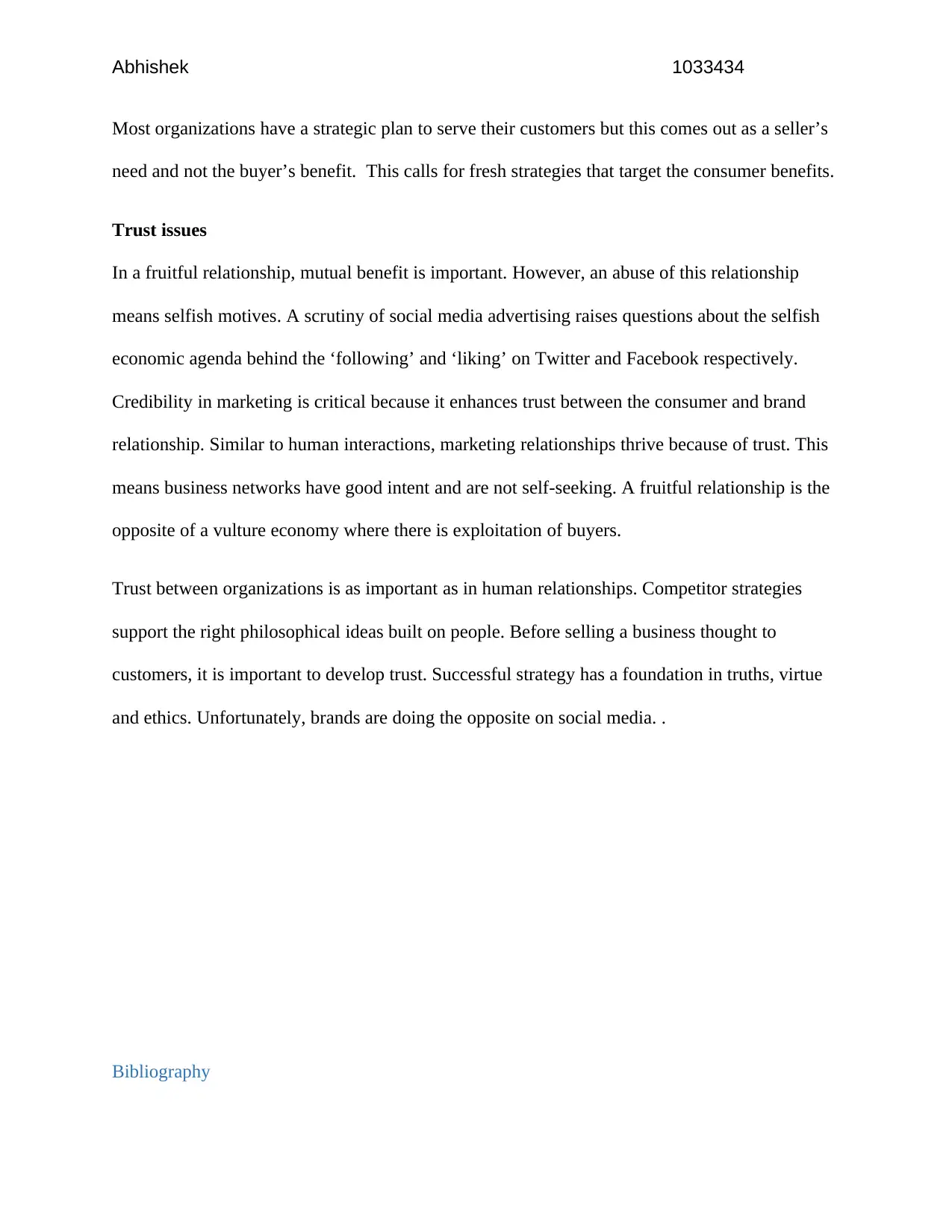
Abhishek 1033434
Most organizations have a strategic plan to serve their customers but this comes out as a seller’s
need and not the buyer’s benefit. This calls for fresh strategies that target the consumer benefits.
Trust issues
In a fruitful relationship, mutual benefit is important. However, an abuse of this relationship
means selfish motives. A scrutiny of social media advertising raises questions about the selfish
economic agenda behind the ‘following’ and ‘liking’ on Twitter and Facebook respectively.
Credibility in marketing is critical because it enhances trust between the consumer and brand
relationship. Similar to human interactions, marketing relationships thrive because of trust. This
means business networks have good intent and are not self-seeking. A fruitful relationship is the
opposite of a vulture economy where there is exploitation of buyers.
Trust between organizations is as important as in human relationships. Competitor strategies
support the right philosophical ideas built on people. Before selling a business thought to
customers, it is important to develop trust. Successful strategy has a foundation in truths, virtue
and ethics. Unfortunately, brands are doing the opposite on social media. .
Bibliography
Most organizations have a strategic plan to serve their customers but this comes out as a seller’s
need and not the buyer’s benefit. This calls for fresh strategies that target the consumer benefits.
Trust issues
In a fruitful relationship, mutual benefit is important. However, an abuse of this relationship
means selfish motives. A scrutiny of social media advertising raises questions about the selfish
economic agenda behind the ‘following’ and ‘liking’ on Twitter and Facebook respectively.
Credibility in marketing is critical because it enhances trust between the consumer and brand
relationship. Similar to human interactions, marketing relationships thrive because of trust. This
means business networks have good intent and are not self-seeking. A fruitful relationship is the
opposite of a vulture economy where there is exploitation of buyers.
Trust between organizations is as important as in human relationships. Competitor strategies
support the right philosophical ideas built on people. Before selling a business thought to
customers, it is important to develop trust. Successful strategy has a foundation in truths, virtue
and ethics. Unfortunately, brands are doing the opposite on social media. .
Bibliography
⊘ This is a preview!⊘
Do you want full access?
Subscribe today to unlock all pages.

Trusted by 1+ million students worldwide
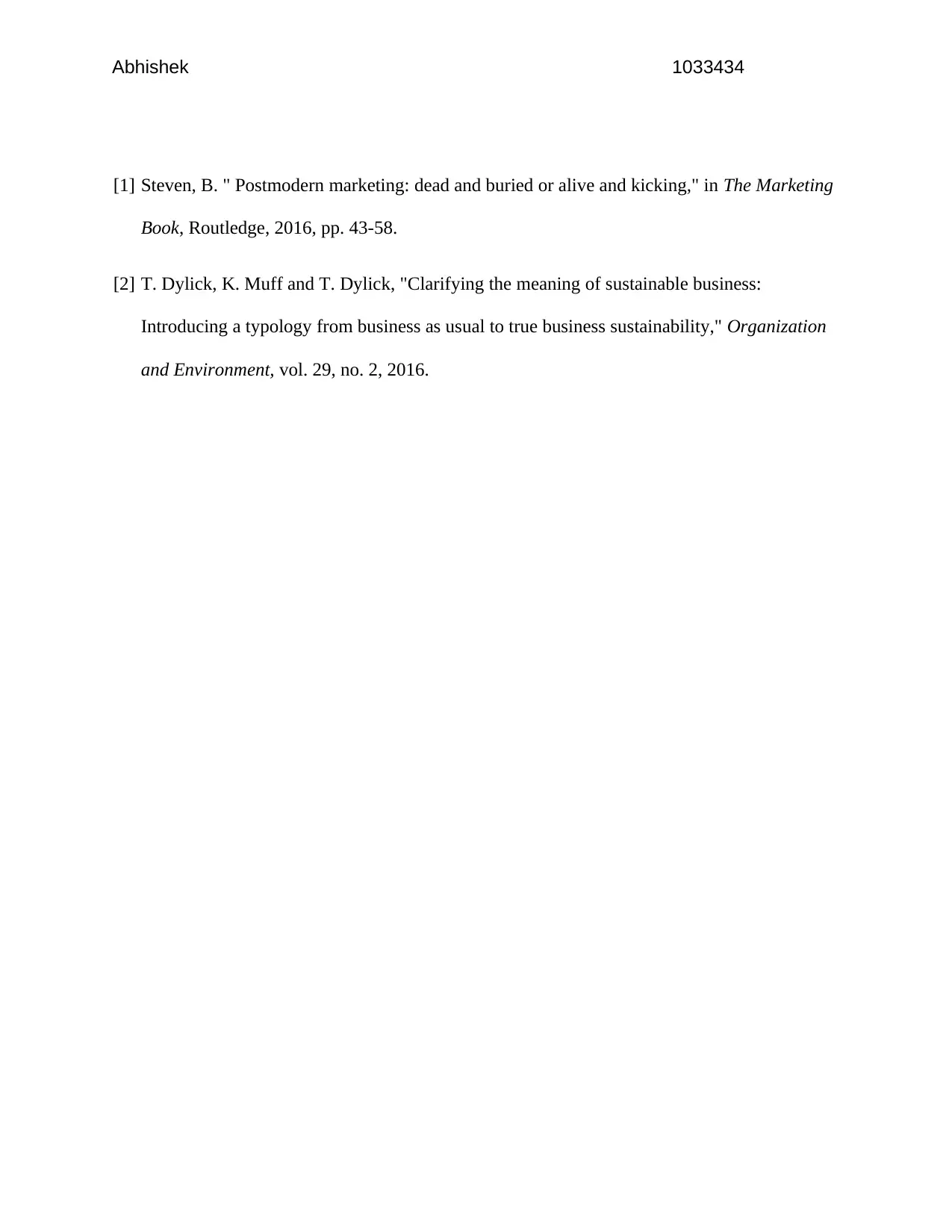
Abhishek 1033434
[1] Steven, B. " Postmodern marketing: dead and buried or alive and kicking," in The Marketing
Book, Routledge, 2016, pp. 43-58.
[2] T. Dylick, K. Muff and T. Dylick, "Clarifying the meaning of sustainable business:
Introducing a typology from business as usual to true business sustainability," Organization
and Environment, vol. 29, no. 2, 2016.
[1] Steven, B. " Postmodern marketing: dead and buried or alive and kicking," in The Marketing
Book, Routledge, 2016, pp. 43-58.
[2] T. Dylick, K. Muff and T. Dylick, "Clarifying the meaning of sustainable business:
Introducing a typology from business as usual to true business sustainability," Organization
and Environment, vol. 29, no. 2, 2016.
1 out of 7
Related Documents
Your All-in-One AI-Powered Toolkit for Academic Success.
+13062052269
info@desklib.com
Available 24*7 on WhatsApp / Email
![[object Object]](/_next/static/media/star-bottom.7253800d.svg)
Unlock your academic potential
Copyright © 2020–2025 A2Z Services. All Rights Reserved. Developed and managed by ZUCOL.





